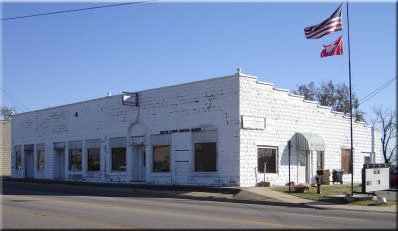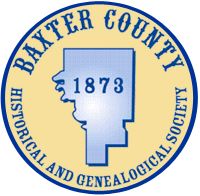Rollins Hospital
Where Baxter County's Medicine Became Modern
The Rollins Hospital, 107 East Main Street in Gassville, is a concrete block structure built in 1923. It was the first building to be fully utilized as a hospital in Baxter County, and for many years was the only hospital serving surrounding Fulton, Izard, and Marion counties.
With local significance for its association with early health care in Gassville, the building was nominated to the National Register of Historic Places and was listed in the Register on September 20, 2007.

Gassville’s Rollins Hospital was founded by Dr. William James Rollins. He was born in what is now the city of Shawnee, Oklahoma, on February 9, 1892 (Shawnee became a city in 1895, and Oklahoma became a state in 1907). He was one of five children (three of whom became doctors). He grew up in Shawnee and lived at 414 North Tucker Street.Rollins attended high school in Shawnee and went to St. Louis University Medical School to become a dentist in 1910. After finishing dental school he then returned to the same school to become a medical doctor. Dr. Rollins worked as a barber while attending medical school. He met and married Ada Russell there during his time in medical school while she was working in a Kress department store. The couple moved to Gassville in 1920 and Dr. Rollins began his medical practice soon after their arrival.
The hospital that Dr. Rollins opened in 1923 was significant for several reasons. It was the first hospital in the area. At the time most doctors in the area had an office and maybe one or two rooms set aside for patients, but for the most part patients were treated at home. Prior to its opening, the nearest hospital was located in Harrison, Boone County, Arkansas, a full 50 miles away. The mountains and unpaved roads of north central Arkansas complicated the lengthy 50-mile trek making it nearly impossible for anyone in dire need of hospital services to make it to the hospital quickly enough. Rollins Hospital opened up the possibility for professional medical care in a hospital setting to a host of people who had never had access to it before. Patients from larger communities in neighboring counties and even from the neighboring state of Missouri made the trip to Rollins Hospital due to the scarcity of medical care in the area.
Another factor that contributed to the popularity of Rollins Hospital was the doctor himself who treated everyone who came to him. His attitude toward medical care was that the patient and needs came before he considered whether they could pay for his services. In fact, he is rumored to have treated notorious outlaws of the day and even they found ways to pay their bills. Many of his patients paid with meat, produce and when he was lucky they might offer him moonshine.
Another testament to Dr. Rollins’ concern for his patients was his willingness to use his car for an ambulance. In the rough terrain of the area he often got the car stuck in creeks that he had to ford. At times, his grandson, Bill, was sent to a nearby farmer’s house to get the mules or horses to get the car out of the creek. The hospital later obtained its own ambulance.
Dr. Rollins proved himself to be a colorful character in the area and much of his personality had an impact on the community through his work at the hospital. In addition to his unconventional methods of accepting payment, he also had some strange work habits that would not be acceptable in modern medicine. Dr. Rollins enjoyed the moonshine that he received as payment for bills and kept a supply in the pharmacy. His wife was not keen on his moonshine habit and it is said that when the nurses would see Mrs. Rollins coming over to the hospital from the house, they would begin singing “Onward Christian Soldiers” to warn the doctor to put the moonshine away.
Dr. Rollins had a German shepherd named “Sir Boss,” who was in the hospital daily making rounds with the doctor. The dog was well known in the community as he took mail to the post office and brought the mail back to the hospital as well. The dog was, in fact, such a known fixture in Gassville that when he died his obituary was announced in the Baxter Bulletin. Dr. Rollins was also known to always smoke a cigar when he was working on a patient or checking on a patient. The vibrant personality of Dr. Rollins coupled with his sincere desire to help people was a part of the great draw to this institution in the region.
When Dr. Rollins originally built the 1923 portion of the building he was only using one third of the structure as the hospital. He leased the remainder of the space to a store and a movie theater. He later expanded the hospital into those spaces as the businesses left. The third of the building utilized by Dr. Rollins included an office, exam room, and two patient rooms. In those early years the hospital was a success and much needed addition to the area; however, in the mid-1930s, Dr. Rollins decided that the hospital could use the addition of a surgeon.
He traveled to Chicago to find a surgeon to work in his hospital. Dr. Rollins found Dr. John F. Guenthner working as a resident at a Chicago hospital and talked him into coming to Gassville to work for him. Dr. Rollins offered him $2500.00 a year which was a vast improvement over the $600.00 a year he was making in Chicago. Dr. Guenthner drove a new Buick from Chicago to Gassville in 1936 to begin working for Dr. Rollins. In 1937 the pair added the last rooms to the hospital and had a grand opening celebration.
In 1946, Dr. Rollins sold his partnership in the hospital to Dr. Guenthner and they changed the name of the hospital from Rollins Hospital to Baxter County Community Hospital.
Dr. Guenthner operated the Baxter County Community Hospital for several years. He sold the hospital to Dr. J.A. Van Bebers around 1952. The building remained in use as a hospital until Dr. Van Bebers’ death in November 1954. The hospital closed the day after Dr. Van Bebers passed away. Any patients remaining in the hospital that day were told to find another hospital or to go home. The building later operated as a nursing home for a short while, but November of 1954 was the last time the building functioned as a hospital.After the closure of the hospital, the nearest place to receive medical services was at a clinic in Mountain Home, Baxter County, Arkansas, approximately fifteen miles away. Additionally, Dr. Rollins opened another clinic in the area after leaving his hospital to Dr. Guenthner.
In the late 1940s Dr. Rollins retired and moved to Cotter, Baxter County, Arkansas. His popularity was evident as he had so many visitors to his home seeking medical treatment that he eventually opened a small office in Cotter. He practiced medicine here, mostly for free, until the office burned. Dr. Rollins died January 10, 1957 and is buried in the Gassville cemetery. The clinic in Mountain Home remained open until 1965. The clinic closed to make room for a state sponsored hospital in Baxter County.
Before closing in 1954, Rollins Hospital was the only hospital in the region. After ceasing operations as a hospital, the building has been actively used in Gassville for several other purposes. As already mentioned, the building operated as a nursing home for a short time. It was later used as a warehouse for the shirt factory that opened in Gassville in the 1950s. The building was later purchased by J.A. Gregory who converted it into a commercial strip in the 1960s. At this time the building was subdivided on the interior to be three distinct spaces. Two additional entrances were added to the front of the building to provide access to the separate interior spaces. Over the years these spaces were occupied by a real-estate company, a dental office, and various retail operations. The building was later turned over to the Baxter County Historical and Genealogical Society who operated it as a museum celebrating both Dr. Rollins and Baxter County History. The building was later sold to a private individual. It’s function today is noted below.
Source: Arkansas Historic Preservation Program, http://www.arkansaspreservation.com. Reprinted with permission.
